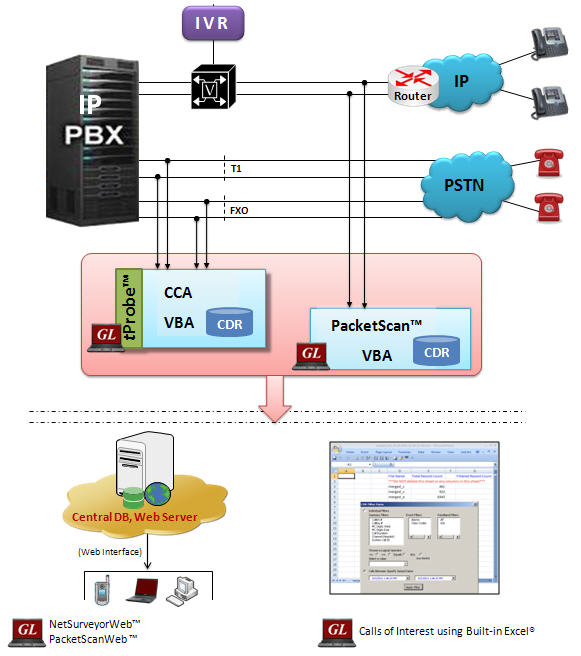Testing IVR (Interactive Voice Response) Systems
Welcome to another April, 2013 issue of GL Communications' newsletter providing information and insight into our Testing IVR (Interactive Voice Response) Systems.

Overview
IVR (Interactive Voice Response) Systems depend on DTMF digits, or tones, as inputs from the users and in turn presents a menu for banking, hospitality, voice mail, and other automated applications. Depending on the application, the branching of the menu can get complicated, and this requires accurate testing prior to deployment.
When calling an IVR system from any interface, the user is asked to send DTMF digits in response to prompts. The IVR system may have several sequences and may require either single DTMF digit responses or several DTMF digit responses (i.e. the credit card number). Once through the IVR system the user will either be connected to real voice or the user will simply be disconnected.
Using GL products with their associated scripting, it is possible to automate the IVR process. GL's IVR test platforms can generate and detect user-defined digits, tones, and play/record voice files, using a simple GUI setup or automate the whole process through scripts. Automatic IVR testing is possible via scripting and is possible with any GL supported emulation product. The scripting provides the means to detect voice and send DTMF digits in response to voice prompts. Once connected to the call, the GL product can perform Quality of Service (PESQ) or path confirmation tests.
GL Products Supporting IVR testing
- VQuad™ with Dual Universal Telephone Adapter (Dual UTA) supports multiple interfaces and processes through the IVR using scripts. IVR testing is supported over a variety of interfaces including FXO 2-wire, T1 E1 (PRI and CAS), Bluetooth Mobile, VoIP SIP, Phone Handset, and Radio PTT. Among aforesaid supported interfaces, some allow the place call sequence (FXO, Bluetooth, SIP, T1 E1) whereas other interfaces may assume the call is connected prior to going through the IVR process.
- VQuad™ – Lite is a variation of VQuad™ with Dual Universal Telephony Adapter (UTA) that supports maximum of 2 Devices in FXO, or Mobile Wireless network, with each device associated to one telephony device (Bluetooth® / FXO).
- VQuad™ Probe is an all-in-one self-contained VQuad™ with Dual UTA test instrument. This comprehensive hardware device incorporates all the features of the current VQuad™ with Dual UTA unit such as portability and remote accessibility along with the necessary PC hardware with Win7 OS.
- PacketGen™ or RTP Toolbox™ (Over Packet Networks)
PacketGen™ and RTP ToolBox™ with powerful traffic action scripting capability for RTP traffic generation can simulate IVR kind of systems over packet networks. - T1 E1 Analyzer (Over T1 E1, Analog, SS7, ISDN Networks)
Over T1 E1 and analog networks, the GL's T1 E1 Analyzer with hardware establishes voice channels supporting TDM traffic (voice, digits, and tones) simulating IVR systems. - MAPS™ (Over T1 E1, Analog, Wireless, Packet Networks)
MAPS™ test equipments include traffic generators and detectors to perform IVR testing of all types of traffic over TDM, TRAU, and Packet networks. - DCOSS (Over Over T1 E1, Analog, SS7, ISDN Networks)
DCOSS can automatically answer a call, play a series of user-defined prompts, and employ number recognition in order to gather information, identify errors and fully test an Interactive Voice Response (IVR) system.
Main Features
- Simulate IVR Users and IVR System
- Single-box portable solution and Rackmount PC solution for higher density
- Complete automation with enhanced scripting and remote operation including traffic generation and call control scripting
- Automate the IVR testing process - call establishment and traffic generation detection process through scripts.
- Voice menu testing (using bulk call scripting)
- Voice recognition testing (using bulk call scripting)
- Monitoring IVR System for voice and data quality
- Perform Quality of Service (PESQ) or path confirmation tests
- Within a proper voice call, additional analysis is available such as Round Trip Delay (RTD) and Voice Quality Testing (VQT).
- Support for Command Line Interface (CLI) to access VQuad™ remotely
Scenario 1: IVR Testing using VQuad™
IVR User Simulation with VQuad™
- placing a call
- waiting for certain time duration after call connection
- send DTMF 1, pause 4s,
- send DTMF 2, pause 4s,
- send DTMF 3, wait 10s and so on
- waiting for certain time duration to receive tones from the IVR system
IVR System Simulation with VQuad™
- detects the incoming digit traffic and performs the operations based on the digits detected
- for example, if digit 1 is detected, VQuad™ sends tones and if digit 2 is detected, VQuad™ sends voice file.
Scenario 2: IVR Monitoring over TDM Network and IP Network
(using T1 E1 Analyzer, and PacketScan™ respectively)

GL's Call Capture and Analysis (CCA, PacketScan™, PPP Analyzer) solution is used to capture and monitor live traffic over TDM, and Packet networks. The output of this system centers around each 'call' and for each call it reports comprehensive information occurring on T1 and E1 lines and IP networks.
For comprehensive information, please visit our IVR (Interactive Voice Response) Systems web page.


 Back to Newsletter Index Page
Back to Newsletter Index Page